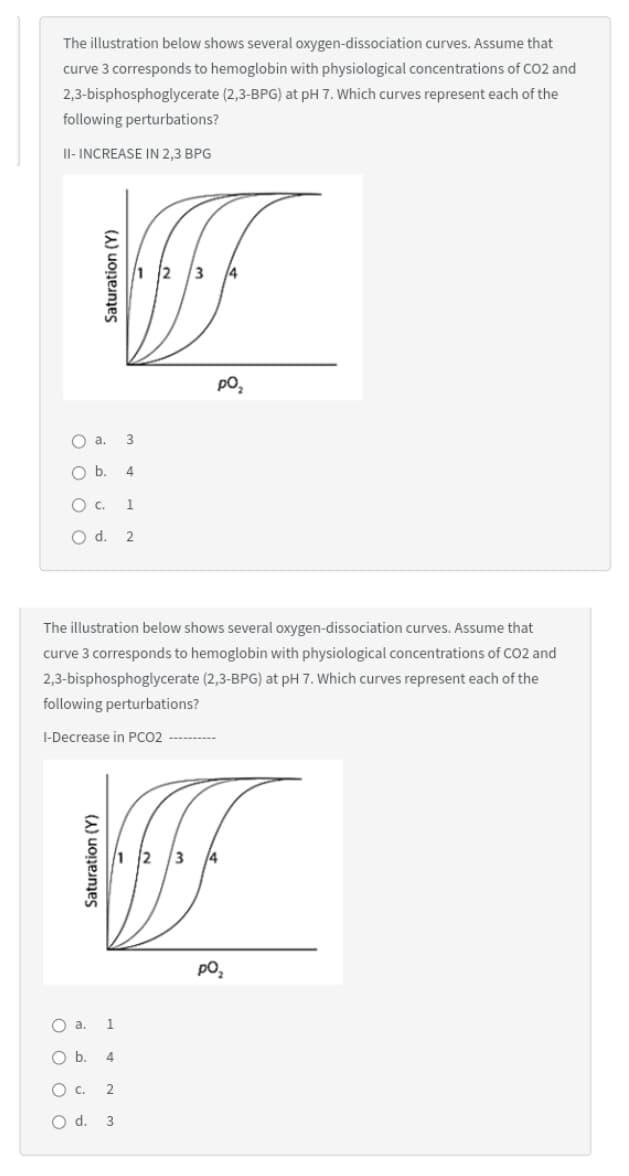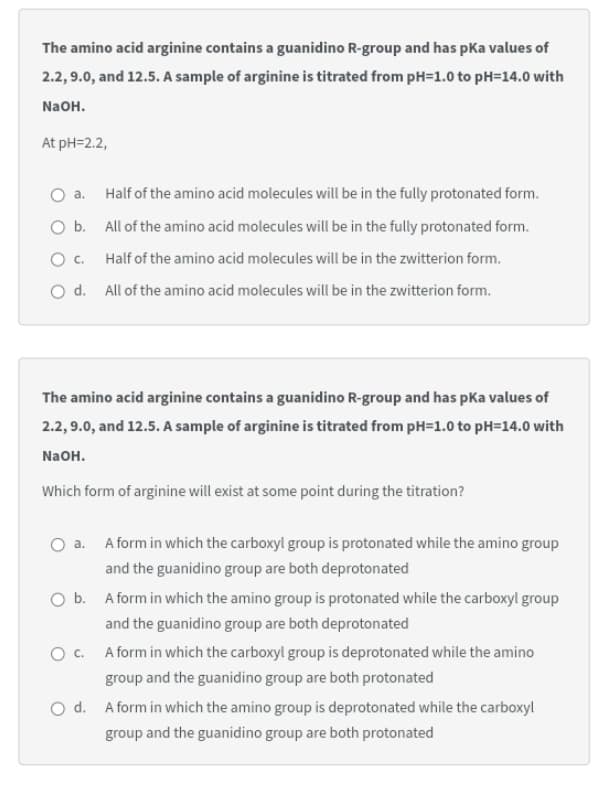The illustration below shows several oxygen-dissociation curves. Assume that curve 3 corresponds to hemoglobin with physiological concentrations of co2 and 2,3-bisphosphoglycerate (2,3-BPG) at pH 7. Which curves represent each of the following perturbations? II- INCREASE IN 2,3 BPG 1 2 /3 po, O a. 3 O b. 4 O c. 1 O d. 2 The illustration below shows several oxygen-dissociation curves. Assume that curve 3 corresponds to hemoglobin with physiological concentrations of CO2 and 2,3-bisphosphoglycerate (2,3-BPG) at pH 7. Which curves represent each of the following perturbations? I-Decrease in PCO2 -------- pO, О а. 1 Saturation (Y) Saturation (Y)
The illustration below shows several oxygen-dissociation curves. Assume that curve 3 corresponds to hemoglobin with physiological concentrations of co2 and 2,3-bisphosphoglycerate (2,3-BPG) at pH 7. Which curves represent each of the following perturbations? II- INCREASE IN 2,3 BPG 1 2 /3 po, O a. 3 O b. 4 O c. 1 O d. 2 The illustration below shows several oxygen-dissociation curves. Assume that curve 3 corresponds to hemoglobin with physiological concentrations of CO2 and 2,3-bisphosphoglycerate (2,3-BPG) at pH 7. Which curves represent each of the following perturbations? I-Decrease in PCO2 -------- pO, О а. 1 Saturation (Y) Saturation (Y)
Chemistry
10th Edition
ISBN:9781305957404
Author:Steven S. Zumdahl, Susan A. Zumdahl, Donald J. DeCoste
Publisher:Steven S. Zumdahl, Susan A. Zumdahl, Donald J. DeCoste
Chapter1: Chemical Foundations
Section: Chapter Questions
Problem 1RQ: Define and explain the differences between the following terms. a. law and theory b. theory and...
Related questions
Question

Transcribed Image Text:The illustration below shows several oxygen-dissociation curves. Assume that
curve 3 corresponds to hemoglobin with physiological concentrations of CO2 and
2,3-bisphosphoglycerate (2,3-BPG) at pH 7. Which curves represent each of the
following perturbations?
II- INCREASE IN 2,3 BPG
po,
O a. 3
O b. 4
O c. 1
O d. 2
The illustration below shows several oxygen-dissociation curves. Assume that
curve 3 corresponds to hemoglobin with physiological concentrations of cO2 and
2,3-bisphosphoglycerate (2,3-BPG) at pH 7. Which curves represent each of the
following perturbations?
I-Decrease in PCO2
1 2
3
14
pO,
O a.
1
O b. 4
Ос. 2
O d. 3
Saturation (Y)
Saturation (Y)

Transcribed Image Text:The amino acid arginine contains a guanidino R-group and has pka values of
2.2, 9.0, and 12.5. A sample of arginine is titrated from pH=1.0 to pH=14.0 with
NaOH.
At pH=2.2,
O a.
Half of the amino acid molecules will be in the fully protonated form.
O b. All of the amino acid molecules will be in the fully protonated form.
O . Half of the amino acid molecules will be in the zwitterion form.
O d. All of the amino acid molecules will be in the zwitterion form.
The amino acid arginine contains a guanidino R-group and has pka values of
2.2, 9.0, and 12.5. A sample of arginine is titrated from pH=1.0 to pH=14.0 with
NaOH.
Which form of arginine will exist at some point during the titration?
a. A form in which the carboxyl group is protonated while the amino group
and the guanidino group are both deprotonated
O b. A form in which the amino group is protonated while the carboxyl group
and the guanidino group are both deprotonated
O C. A form in which the carboxyl group is deprotonated while the amino
group and the guanidino group are both protonated
O d. A form in which the amino group is deprotonated while the carboxyl
group and the guanidino group are both protonated
Expert Solution
This question has been solved!
Explore an expertly crafted, step-by-step solution for a thorough understanding of key concepts.
This is a popular solution!
Trending now
This is a popular solution!
Step by step
Solved in 2 steps with 2 images

Knowledge Booster
Learn more about
Need a deep-dive on the concept behind this application? Look no further. Learn more about this topic, chemistry and related others by exploring similar questions and additional content below.Recommended textbooks for you

Chemistry
Chemistry
ISBN:
9781305957404
Author:
Steven S. Zumdahl, Susan A. Zumdahl, Donald J. DeCoste
Publisher:
Cengage Learning

Chemistry
Chemistry
ISBN:
9781259911156
Author:
Raymond Chang Dr., Jason Overby Professor
Publisher:
McGraw-Hill Education

Principles of Instrumental Analysis
Chemistry
ISBN:
9781305577213
Author:
Douglas A. Skoog, F. James Holler, Stanley R. Crouch
Publisher:
Cengage Learning

Chemistry
Chemistry
ISBN:
9781305957404
Author:
Steven S. Zumdahl, Susan A. Zumdahl, Donald J. DeCoste
Publisher:
Cengage Learning

Chemistry
Chemistry
ISBN:
9781259911156
Author:
Raymond Chang Dr., Jason Overby Professor
Publisher:
McGraw-Hill Education

Principles of Instrumental Analysis
Chemistry
ISBN:
9781305577213
Author:
Douglas A. Skoog, F. James Holler, Stanley R. Crouch
Publisher:
Cengage Learning

Organic Chemistry
Chemistry
ISBN:
9780078021558
Author:
Janice Gorzynski Smith Dr.
Publisher:
McGraw-Hill Education

Chemistry: Principles and Reactions
Chemistry
ISBN:
9781305079373
Author:
William L. Masterton, Cecile N. Hurley
Publisher:
Cengage Learning

Elementary Principles of Chemical Processes, Bind…
Chemistry
ISBN:
9781118431221
Author:
Richard M. Felder, Ronald W. Rousseau, Lisa G. Bullard
Publisher:
WILEY